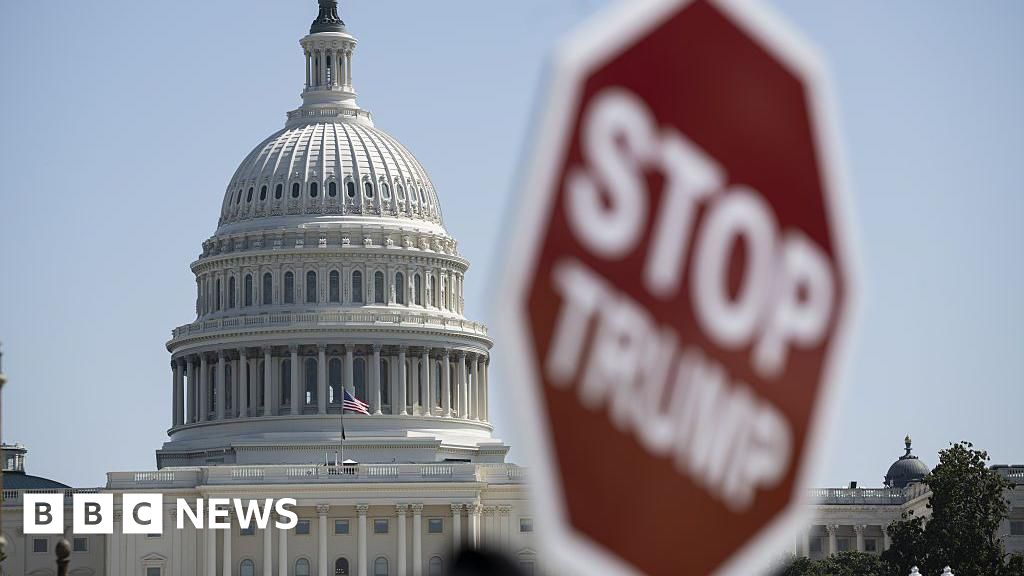Business
Why the US government has shut down and what happens now

Anthony ZurcherNorth America correspondent and
James FitzGerald
Funding for the US government has been cut off after President Donald Trump’s Republican Party failed to agree with opposition Democrats on a way forward on a spending bill.
The news means that some – but not all – US government services will come to a temporary halt.
Although budget confrontations are common in US politics, this spending fight is especially tense because Trump has spent the last nine months drastically cutting the size of the national government.
Why has the US government shut down?
This situation results from the inability of the two parties to come together and pass a bill funding government services into October and beyond.
The Republicans control both chambers of Congress, but in the Senate – or upper chamber – they are short of the 60 votes they need to pass a spending bill.
Democrats, therefore, have some leverage in this case. They refuse to back a Republican bill, saying it will make it harder for Americans to afford healthcare, and have made this standoff primarily about advancing their healthcare policy goals.
They are calling for an extension of tax credits that make health insurance cheaper for millions of Americans – which are set to expire – and for a reversal of cuts to Medicaid that have been made by Trump. Democrats also oppose spending cuts to the Centers for Disease Control (CDC) and National Institutes of Health (NIH).
A stopgap bill was earlier passed in the House, or lower chamber, but is yet to clear the Senate.
When did the shutdown happen?
At 00:01 EDT on Wednesday (04:01 GMT), it became official: the US would have its first shutdown for nearly seven years.
The last time this happened was at the end of 2018, during Trump’s first term. Both sides made last-ditch efforts to avoid a repeat this time.
On Monday, Trump met all four congressional leaders – the top Democrats in the House and Senate as well as their Republican counterparts. But there was little progress, and both sides appear to have dug deeper into their positions.
On the Republican side, Trump administration officials have been unwilling, so far, to offer any substantive concessions.
They appear to believe Democrats, as the side making demands in exchange for keeping the government open, will bear the brunt of the public’s blame – as they have in some past shutdowns.
Democrats, meanwhile, believe their push for preserving health-insurance subsidies is a popular one.
What is more, their congressional leaders provoked the ire of left-wing activists for backing down during the last budget bout in March. Many Democrats are itching for a bigger fight this time around – and funding the government is one of the only places where their party has some leverage.
What’s different about the White House response this time?
What stands out about this current standoff is the position of Trump’s team.
In the past, long shutdowns were usually seen as politically dangerous, hampering both voters’ everyday lives and the images of lawmakers and the president.
But this time around, the Trump administration appears more than happy to shutter large parts of the US government for an extended period. In fact, officials have threatened to use a shutdown to identify “non-essential” workers who could then be permanently let go.
“We’ll be laying off a lot of people,” Trump said on Tuesday.
Also, after previous shutdowns, government operations mostly returned to normal, with staff and spending levels largely going back to what they had been before, once the standoff was resolved.
Over the past nine months, however, the Trump administration has slashed spending and pushed workers out of their jobs, testing the boundaries of presidential power. A shutdown could allow the administration to accelerate its massive reductions.
What impacts will the shutdown have – including on national parks and social security?
Not all of government will shut down.
Border protection, in-hospital medical care, law enforcement and air-traffic control are expected to continue to operate during the stoppage.
While social security and Medicare cheques would still be sent out, benefit verification and card issuance could stop.
Generally, in a shutdown, essential workers continue as normal – some of them without pay for the time being – but government employees deemed non-essential are temporarily put on unpaid leave. In the past, these workers have then been paid retrospectively.
That means that services like the food assistance programme, federally-funded pre-school, the issuing of student loans, food inspections, and operations at national parks are expected to be curtailed or closed.
There could also be travel delays if the stand-off drags on and unpaid workers stop showing up.
Overall, analysts expect that this shutdown could be bigger than the one in late 2018, when Congress had passed some funding bills. They expect roughly 40% of federal workers – more than 800,000 people – to be put on temporary leave.
How could this shutdown affect the economy?
The scale of the damage will depend in part on how long the shutdown lasts – and how wide ranging it is.
In the past, disruption has tended to be temporary, with any lost activity mostly made up in the months after the shutdown ends.
Analysts estimate a shutdown this time could shave roughly 0.1 to 0.2 percentage points off economic growth for each week that it lasts – though much of that could be recouped.
That relatively muted impact may be why the stock market seems to be shrugging off this latest threat.
But, again, there are some ways that this shutdown could look different.
For one thing, Trump has threatened to fire – not just furlough – some workers, which would make the impact more long lasting.
The fight is also injecting more turmoil into an economy already being roiled by changes like tariffs and artificial intelligence, with the likely delay of key data – such as the official US monthly jobs report – expected to add to the uncertainty.
How common are shutdowns in the US?
Quite common over the past 50 years.
There were three during Trump’s first term, including the longest in history at 36 days, which ended in January 2019. That one was brought about by disagreements over funding a wall on the Mexico border.
The Congressional Budget Office (CBO) estimated that it reduced economic output by about $11bn, including $3bn that it never regained.
Fellow Republican Ronald Reagan oversaw eight shutdowns during his presidency in the 1980s – though all were relatively brief.
Shutdowns over budgets are almost unique to US politics.
Under the US system, the different branches of government have to reach an agreement on spending plans before they can become law.
In most countries, budget votes become votes of confidence in the government itself. But because the US has equal and often divided branches of government, that is not the case.
Business
Buy or sell: Stock recommendation by brokers for November 19, 2025 – The Times of India

Jefferies has initiated its coverage of WeWork India with a buy rating and a target price of Rs 790. Analysts said that the company is the largest flexible workspace operator by revenues in India. At about 17% compounded annual growth rate (CAGR), flexible workspace stock is growing at two times the pace of office stock, with room for further penetration. They said WeWork’s premium positioning helps command higher average revenue per member and margins than peers.Motilal Oswal Securities has initiated its coverage of PB Fintech with a neutral rating and a target price of Rs 2,000. Analysts expect PB Fintech to post a strong FY25-FY28 revenue, earnings before interest, taxes, depreciation, and amortisation (EBITDA) and profit after tax (PAT) CAGR of 35%, 156% and 56%, respectively, after factoring in a strengthening position in under-penetrated credit and insurance industries. However, they believe the stock is fairly valued, and all positives are priced in at current levels. Any possibility of commission restructuring by insurance companies due to the loss of input tax credit post GST exemption poses a key risk for the company’s top-line growth.Morgan Stanley has an overweight rating on Eternal (formerly Zomato) with the target price at Rs 427. They believe Eternal has the best risk-reward matrix and investors would use the current weakness to accumulate the stock. Like Eternal’s strategy of doubling down on customer market share as wallet share expansion can follow later. Theyassume a stress case of higher aggression could mean push out of profitability but this is not a game changer. They are assuming a stress case scenario where the stock would bottom out at Rs 280 – Rs 285.UBS has a buy rating on Max Healthcare Institute with the target price at Rs 1,550. Analysts expect the company’s brownfield capacity addition to drive growth and earnings. The management said that it recently commissioned a Mohali facility including an oncology facility. It’s also commissioning a facility at Nanavati hospital inMumbai.Also the construction activity at other new hospitals is progressing well. The management indicated that the issues related to cashless service for insurance patients has been resolved and mentioned there was no/only limited impact as patients shift from insurance to cash in such instances.Nomura has a neutral rating on Oil India with the target price at Rs 430. Analysts said the company’s July-Sept quarter was a soft one as volumes were impacted by external factors. The expansion work at Numaligarh Refinery was on track, with first crude intake expected next month and a meaningful volume uptick by the July-Sept quarter ofnext year. Analysts cut Oil India’s FY26 and FY27 profit estimates by 37% and 18%, respectively, to reflect: Lower gas sales volume, lower crude price realizations, higher depletion & depreciation expenses, and sharply higher exploratory write-offs and impairments.
Business
Top stocks to buy today: Stock recommendations for November 19, 2025 – check list – The Times of India

Stock market recommendations:According to Mehul Kothari, DVP – Technical Research, Anand Rathi Shares and Stock Brokers, the top stocks to buy today are Life Insurance Corporation of India, Coromandel, and Doms Industries:Life Insurance Corporation of India – Base Formation near 200-DEMA + Dual MACD Bullish CrossoverBuy near: ₹920–₹910 | SL: ₹885 | Target: ₹975 | Time Frame: 90 DaysLife Insurance Corporation of India has developed a strong base near the 200-DEMA, indicating that the recent decline is stabilizing around a crucial long-term support. A bullish divergence on the hourly chart suggests that downside momentum is fading and buyers are gradually stepping in. On the daily timeframe, both the short-term and long-term MACD have produced a bullish crossover above the zero line — a powerful signal hinting at a potential trend reversal.These technical factors collectively point to improving strength and increase the probability of an upward move toward ₹975. Traders may look to build long positions in the ₹920–₹910 zone.Coromandel – Support at 200-DEMA/SMA + Long-Term MACD DivergenceBuy near: ₹2215–₹2200 | SL: ₹2095 | Target: ₹2450 | Time Frame: 90 DaysCoromandel has taken strong support at both the 200-DEMA and 200-SMA — a zone that has historically acted as a reliable demand area for long-term buyers. The long-term MACD has formed a bullish divergence, indicating weakening downside momentum and the possibility of a trend reversal. Price action is gradually showing early signs of recovery, while the 25-period ROC on the hourly chart has turned positive, affirming improving momentum.Given this confluence of technical signals, the stock presents a favourable risk–reward opportunity in the ₹2215–₹2200 zone for a potential move toward ₹2450.DOMS – Breakout Above 2580 + Momentum Revival Through MACDBuy near: ₹2580–₹2540 | SL: ₹2450 | Target: ₹2800 | Time Frame: 90 DaysDoms Industries Ltd has established a strong base within the ₹2500–₹2580 consolidation zone, reflecting sustained accumulation at lower levels. On 14-11-2025, the stock confirmed a decisive breakout above the ₹2580 mark, signalling fresh buying interest and a likely continuation of the prevailing uptrend. This breakout is further supported by a bullish MACD crossover above the zero line, indicating strengthening momentum on the higher timeframes.With both price structure and momentum indicators aligning positively, DOMS offers a robust setup for an upside move toward ₹2800.(Disclaimer: Recommendations and views on the stock market, other asset classes or personal finance management tips given by experts are their own. These opinions do not represent the views of The Times of India)
Business
Adverts for Booking.com and three major hotel chains banned over misleading prices

Four major players in the travel industry have had their adverts banned by the Advertising Standards Authority (ASA) for misleading customers.
The ASA ruled that Booking.com and hotel groups Accor, Travelodge, and Hilton all used “from” price claims for hotel rooms that overstated how many were available at the advertised rate.
With only a limited proportion of rooms genuinely offered at the advertised prices across various dates, the ASA deemed the promotions misleading and consequently prohibited their future use.
In Booking.com’s case, an ad on May 6 stated “Places to stay in Sheffield – Best Price Guarantee, and further text read “easyHotel Sheffield City Centre From £28”.
Booking.com said the dates and prices displayed were “dynamically chosen” by Google from data it provided, meaning they could vary for each user and search.
They believed the information displayed in the ad was accurate and not misleading.
The ASA said the data Booking.com provided showed that seven bookings were made at the easyHotel Sheffield City Centre for the advertised price in May.
It said it did not receive any other information from Booking.com, such as the number of dates on which rooms were available for £28, to enable us to make an adequate assessment of the proportion of rooms at the hotel available at the advertised price and therefore considered that the information provided was insufficient to substantiate the claim “From £28”.
The watchdog found Accor’s ad for £27 rooms at its Ibis Budget Birmingham Centre were only available for a night’s stay on July 30, and was therefore “not a true reflection of the price most consumers could expect to pay”.
It said consumers would understand the claims “Travelodge Nottingham Riverside From £25” and “Travelodge Swansea M4 From £21” to mean that a significant proportion of rooms at each hotel would be available at the advertised price.
However, it understood that the advertised prices were only available to book for a night’s stay on May 18.
In Hilton’s case, the ASA said it had not seen sufficient evidence to demonstrate that a significant proportion of hotel rooms were available at the advertised prices of £68 at Hampton by Hilton Hamilton Park or £59 at Hampton by Hilton Newcastle.

ASA operations manager Emily Henwood said: “Advertised prices must match what’s really available.
“If only a few rooms are actually offered at the price shown, or it only applies to a specific date, then this information must be made clear to avoid misleading people.
“Otherwise, it’s unfair to anyone trying to find a good deal or make informed choices about where to book.
“People should be able to trust the prices they see in ads and these rulings show that we will take action if the rules are broken.”
Travelodge said in a statement: “Travelodge takes its responsibilities under the ASA advertising guidelines seriously. The prices shown in the ads were generated from our live pricing feed and represented the cheapest bookable date available.
“We recognise that customers expect clarity and transparency in pricing, and we continue to work closely with Google to ensure all ad formats are clear and fully compliant. This particular ad format was removed prior to the ASA ruling, and we remain committed to transparent, accurate, and great-value pricing for all our customers.”
-

 Tech1 week ago
Tech1 week agoFrom waste to asset: Turning ethanol production CO₂ into jet fuel
-

 Tech3 days ago
Tech3 days agoNew carbon capture method uses water and pressure to remove CO₂ from emissions at half current costs
-

 Politics5 days ago
Politics5 days agoBritish-Pakistani honoured for transforming UK halal meat industry
-

 Sports3 days ago
Sports3 days agoTexas A&M officer scolds South Carolina wide receiver after touchdown; department speaks out
-

 Business4 days ago
Business4 days agoThese 9 Common Money Mistakes Are Eating Your Income
-

 Business4 days ago
Business4 days agoWhat’s behind Rachel Reeves’s hokey cokey on income tax rises?
-

 Tech1 week ago
Tech1 week agoSecurity flaws in portable genetic sequencers risk leaking private DNA data
-

 Fashion6 days ago
Fashion6 days agoAdidas & Patrick Mahomes expand NIL programme with Texas Tech athletes





